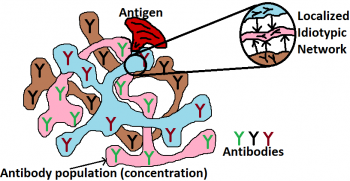The actual working of the Biological Immune System still remains elusive. While many have tried to formulate and use whatever is known about it in the form of algorithms, the real kick is still a far cry! Clonal selection was used in a bid to realize security in computer networks. But from a computational perspective one wonders how much of it was really used or whether it is all that reliable, robust and viable.
Jerne’s Idiotypic network, which suggested that the antibodies form a network by themselves using what are called as Idiotopes was and continues to be an enticing theory. Many things yet remain unexplained. At least it seemed so even when Jerne delivered his Nobel lecture and maybe still is. How does such a network exist in the plasmatic, distributed and well almost decentralized state within the body?
Farmer’s equation that depicts the dynamics of such a network in terms of concentration of antibodies throws insights into how a computational model can be developed. Ishiguro et al showed how the Idiotypic network can be used in conjunction with Farmer’s equation to realize a robot that could autonomously be able to arbitrate its behavior to achieve a goal. Such implementations no doubt throw more light on how one can apply the Idiotypic network model to solve real world problems. However, one can note that they seem to lack in emulating the true distributed nature of the biological immune system.
The real drawback of such systems is that they do not take into account nor exhibit the inherent distributed, decentralized and parallel nature of the biological immune system where each immune cell by itself acts a processor and their numbers are numerous. Farmer’s equation merely suggests the use of a dynamic concentration, a value that actually metaphorizes the vast population of independent antibodies, to eventually form the Idiotypic network.
But in the real world we have several populations of heterogeneous antibodies/immune cells which are independent units within a system. How do these actually form an Idiotypic network? (Obviously there is no global entity that keeps track and updates their individual concentrations as is done in a mere simulation!)
Does every antibody (individual) of one type of population interact with those of another to form the network? If this is so then each antibody would require to send signals (stimulations/suppressions) to interact with each and every other antibody. Is this the way it actually happens in the biological equivalent? If that is so every antibody/cell would need to communicate with every other within the system which of course does not really happen.
In our paper entitled – “On Emulating Real-World Distributed Intelligence Using Mobile Agent Based Localized Idiotypic Networks” we show how, in several populations of heterogeneous antibodies, Idiotypic networks are eventually formed. We postulate that this may be the way things happen in the biological realm. By emulating decentralized and distributed sets of heterogeneous agents (immune cells) moving around in a real network (much the same way as they are in the biological equivalent) we show how these heterogeneous populations optimize and arrive at a common global decision by forming Local Idiotypic Networks (LIN) and thus find a global solution in a distributed and decentralized manner. The emulation could be realized using Typhon.
Farmer’s equation projects how populations of the different antibodies constitute a meta-level network but the actual (real) Idiotypic networks are formed at different spatial locations due to interactions of their sub-populations. What possibly is difficult to comprehend is the manner in which the idiotopes of all the antibodies of one population communicate and stimulate or suppress the others.
Though it is felt (in simulations especially) that all the antibodies of one population stimulate all the others in another population via their idiotopes, this is not the way we envisage things happen in the biological world. We postulate that this happens only locally at the sites where an antigenic attack occurs. During an antigenic attack, the heterogeneous set of antibodies or sub-populations available in the locality of the attack, which are able to cope up with the attack, compete with one another. The ones that are effective in containing the attack suppress those that cannot, forming a Localized Idiotypic Network (LIN) in the locality of the attack. The sub-population of antibodies in this locality that performs better generate signals of suppression to reduce the number of the other sub-populations while the latter stimulate the former to increase the number of the more effective antibodies. The resultant effect is an increase in the number of the more effective antibodies in the locality of attack, thus containing the local antigen population quickly. With such incidents happening at spatially different locations within a body, only the more effective antibodies increase in population while the others remain suppressed.
Further a population of unique antibodies may be able to tackle more than one type of antigen. Such antibodies may also suppress others that are merely primed to tackle one type of antigen. This forms another angle of optimization and contributes to increasing the population of the more-generic antibodies.
To know more read from the paper on On Emulating Real-World Distributed Intelligence Using Mobile Agent Based Localized Idiotypic Networks
We also use Clonal selection to generate new antibodies in “Autonomous Mobile Robot Navigation using an Artificial Immune System“ which will feed the Idiotypic network and keep the show running when some of the existing antibodies within the network die.

